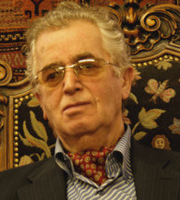
SECAUCUS, NJ -- Funeral services were held for Oriental rug industry leader Nasser Zarnegin, who died Dec. 10 of complications from Parkinson's disease. He was 81.
He is survived by his wife Margaret; his children Jacob, Jacqueline, Daniela, and Debora, and his grandchildren, Pascal Raphael, Celine Raphael, Esther Shamouelian and Joshua Shamouelian.
Nasser Zarnegin, a leading U.S. and European importer and distributor of Oriental Rugs during the past 50 years, was born to Jewish parents in Teheran, Iran, in 1931. His father was a textile merchant; his mother a homemaker. Both parents originally came from Kashan, and they had nine children. Zarnegin left Iran in 1949 to explore and continue his family tradition of trading goods. After a brief visit to the new State of Israel, he settled in London in1950 to study English.
He soon found his way to the port city of Hamburg, Germany, where he opened a household appliance business in 1951. He noticed a brisk trade in carpets and rapidly sensed the emergence of a growth industry in the buying and selling of handmade Oriental carpets. In 1952, this compelled him to change his line of business and open a rug importing company, specializing in old and antique rugs, primarily from Iran.
While maintaining a strong sense of identity with his Persian-Jewish roots, Zarnegin was not comfortable living in Germany during the postwar environment. In 1960, he moved his business to Basel, Switzerland, a prosperous town with a vast network of international trading connections, situated at the crossroads of France and Southern Europe. Zarnegin felt that Basel - with its heritage of spirited affinity for fine art goods - would provide him with a sound base of importing and exporting capabilities. His vision would be confirmed as he proceeded to build one of the largest rug wholesale firms in the world.
Zarnegin’s role as a specialist in Oriental rugs brought him to many important rug weaving centers, as the market for handmade carpets reached new heights. In 1961, he became one of only three representatives of the Soviet state-sponsored rug exporting firm, NOVOEXPORT, enabling his firm to import the most accomplished examples of new and old rug weaving from obscure areas like Daghestan, Armenia, Turkmenistan, and Azerbeijan. The contract with NOVOEXPORT allowed Zarnegin to build deep, uniquely impressive inventories of modern and classic rug weaving. His presence in the middle of major European markets, combined with his intriguing knowledge and genuine fascination of tribal rugs, provided him with a solid reputation.
With his business well-established and thriving, Zarnegin continued his search for the most unusual, profound examples of modern rug making, this time in the southern Persian tribal areas that specialized in primitive Gabbeh carpets. The concept of a Gabbeh was quite obscure during the sixties, mainly because of its primeval, unadulterated texture, its unpretentiousness in design, and its function not only as a carpet, but also as a form of casual furnishing and bedding. Very few specimens of this type were being offered in European markets, and Zarnegin became determined to advance the breadth, depth, and artisanal range of Persian Gabbehs to a receptive body of carpet dealers and consumers. By 1964, Zarnegin became an industry leader in the discovery and recognition of Gabbeh carpets and played an important role in furthering the development of modern Gabbehs.
In 1965, Zarnegin’s quest for unique tribal and village carpets continued to Afghanistan, where he commissioned accomplished weavers to think and produce outside the design realm of traditional Turkoman goods. His efforts resulted in a fusion of color and design that was previously not available to western markets. These innovative Afghan rugs became a great commercial success in Europe, and the production continued until the 1979 Russian invasion of Afghanistan.
The carpet business continued to blossom, as the Nasser Zarnegin company warehouses in Basel soon grew to over 70,000 sq. ft. of exceptional quality and variety, supplying rugs to department, furniture and specialty stores.
Prior to the Iranian revolution of 1979, Zarnegin scoured remote areas of southern Iran, moving with the weavers from one village to another, while introducing great products to the emerging rug markets of his time.
After 1979, with the interruption of trade with Iran and the emergence of the decorative rug market in full stride, Zarnegin was not able to procure the appropriate mix of consumer-driven color and style from his normal sources. This quest for developed - or "programmed" - traditional designs brought him to the organized rug making cooperatives in Romania, which, like the USSR, were also state-sponsored and allowed him to provide input and guidance in color placement and refined finishing techniques.
By 1982, Zarnegin became a leader in Romanian production, with output totaling nearly one million square feet per year, employing over 5000 people at all levels of production. He played a major role in furthering and developing indigenous Transylvanian-style goods at the Harman and Brashov cooperatives in Romania.
In 1986, he established ’Zarnegin International Rug Corporation’, a U.S. branch, which enabled him to become a leader in the supply of tribal goods to the U.S. market.
Zarnegin was always focused on the growth and integrity of his goods, and maintained an optimistic mindset that carried him through discouraging times. His love for the beauty, character, and refinement of tribal and village rugs was displayed with resonance and charm, and he provided a sense of encouragement and possibility for younger dealers in the trade who grew to admire him over the years and cherish their visits with him. His love of children and commitment to the vitality of his family served as an exemplary, inspiring role model.